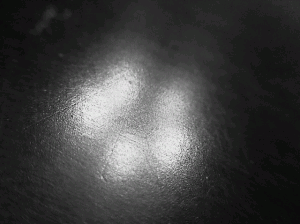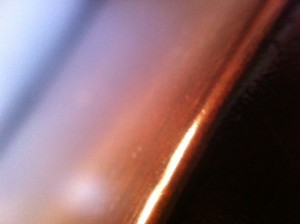Inspiring Interior Design (Part 20)
By Asher Crispe: August 31, 2012: Category Inspirations, Quilt of Translations
Clear Coats and Invisible Surfaces
 Our attention, often entranced by the heaviness of the visible spectrum, permits so much of the ‘barely visible’ to go unnoticed. Catching sight of almost invisible layers of detail requires new eyes. Caught up with the colors, the black and white, and the lighting, we may fail to engage the ordinarily imperceptible coatings that cover objects all around us.
Our attention, often entranced by the heaviness of the visible spectrum, permits so much of the ‘barely visible’ to go unnoticed. Catching sight of almost invisible layers of detail requires new eyes. Caught up with the colors, the black and white, and the lighting, we may fail to engage the ordinarily imperceptible coatings that cover objects all around us.
If one has studied a little bit about optics, then the idea of the wavelengths of light continuing on either side of the visible spectrum is a familiar one. Flanking the blue-violet extreme is ultraviolet light. Commonly thought of as a black light, ultraviolet cannot be seen with the naked eye. In the Zohar we also find a reference to a black light or botsina d’kadrunita which generally denotes the essential of Divine energy that runs through all of the channels of Divine revelation.
Alternatively, since ultraviolet continues the colors on the right axis (see the chart in the previous article) of lovingkindness (blue) and endurance (violet/purple), it could be classified at part of the nistarot or relatively ‘hidden’ soul powers. While others can see how you feel (emotions are relatively revealed soul powers) they cannot see what you are thinking (at least not as clearly). The faculty of thought on the right axis (which is also termed ‘the right brain’) is chochmah or wisdom/intuition/insight. What this tells us is that our intuitions and insights into anything in life are like holding that object or experience up to a black light. Suddenly hidden ‘writing’ with ‘invisible ink,’ the unnoticed details of the world all around us come into view as our minds penetrate below everyday surface appearances.
On the left axis, and flanking the red-orange extremity of the spectrum, we find infrared radiation. Most often thought of in terms of thermal imaging or night vision goggles, infrared light also plays a role as the ‘hidden’ soul power of binah or understanding. Understanding is equated with the left brain. In Kabbalah, there are elemental images that distinguish the overall ‘right’ and ‘left’ and these extend to the right and left brain. Very simply, the right relates to water while the left represents fire. Water ‘clings’ together (glue is mostly water) while fire separates or disintegrates its object. Thus, chochah (intuition) looks at its object as a whole while binah (understanding) breaks it apart through analysis. Consequently, this left-brain soul power has thermal properties. It is the fire–and where there is fire there is heat giving off infrared light.
Kabbalah also speaks about transparencies. While all of the conscious powers of the soul from chochmah (intuition) to malchut (kingdom) have either no finish or a matte finish as ‘furniture’ for our interiors, keter (superconscious crown) does add various coats of ‘polyurethane’ or some other equivalent. Sometimes the superconscious as a whole constitutes a supernal whiteness (lavan ha’elyon) which in actuality acts more like a coat of ‘whitewash’ or a varnish over all of the conscious soul properties. Whitening in this context really means adding a transparent layer which both protects the surfaces and colors underneath and adds some sheen. In other words, the superconscious or unconscious self protects and contributes a soft luster to our conscious self.
On a more detailed level, the superconscious crown has three distinct layers to it. They relate to will (ratzon), pleasure (ta’anug) and faith (emunah) These would translate into three different types of finish: semi-gloss, gloss and matte. The first of these–will–is considered in kabbalah to be a polished light (ohr tzach). When prophecy derives its source from the supernal will, it is said that the prophet sees ‘through a glass darkly’ (aspaklaria sh’aino meirah). This looking glass dims what one sees and therefore relates to the lower level of prophecy that was given to all other prophets other than Moshe (Moses). It only semi-glosses things. They only have a limited shine. Likewise, when we are receptive to the Divine will we are coating all objects and experiences in a new light or a new source of ‘reflection.’ But being informed of what the Creator wants does not leave us with a crystal clear picture. We may still want to know why He wants what He wants (even if the response is super-rational). For that we need to ascend to the next level of the superconscious crown–the aspect of pleasure.
Divine pleasure underlies the Divine will. The same holds true in human psychology. We sense the emerging picture of why someone wants something once we pick up on what they essential take pleasure in or find meaningful. Therefore the aspect of pleasure is referred to as the double polished light (ohr ha’metzuchtzach) in Kabbalah. The extra polish results in a prophetic insight that looks through a ‘looking glass brightly,’ a full translucent or transparent lens (aspaklaria ha’meirah). This is the level of prophecy of Moshe (Moses). It directly taps into things as there are fully glossed and ‘highly reflective’ of (if not reflecting on High) the sheen of Divine pleasure upon them.
 Finally, the highest ‘finish’ resembles no finish at all. This is because it does not shine at all but remains dull and faint. As such it is the most undetectable. In Kabbalah (Zohar II 149b) this is called: “the blackness [ucham] that is the most dark, that has no discernible color within its darkness.” This is the level of faith which is also called the ‘unknowable head’ (reisha d’lo etyada). Ironically, at this level, both a dim and brilliant looking glass are dark. We are talking total ‘black out.’ Everything becomes covered in a layer of fundamental unknowability. The matte finish is almost like a finish which is not a finish. It does not call attention to itself and remains modest and perhaps mysterious. The Zohar also refers to faith as tziuta or modesty. It is the modesty of thought and perception, the epistemic humility that envelopes every object of my interior causing it to withdraw slightly. To my knowing gaze, these furnishings of the soul are most delicate and impenetrable, qualities that they owe specifically to this choice of ‘finish.’
Finally, the highest ‘finish’ resembles no finish at all. This is because it does not shine at all but remains dull and faint. As such it is the most undetectable. In Kabbalah (Zohar II 149b) this is called: “the blackness [ucham] that is the most dark, that has no discernible color within its darkness.” This is the level of faith which is also called the ‘unknowable head’ (reisha d’lo etyada). Ironically, at this level, both a dim and brilliant looking glass are dark. We are talking total ‘black out.’ Everything becomes covered in a layer of fundamental unknowability. The matte finish is almost like a finish which is not a finish. It does not call attention to itself and remains modest and perhaps mysterious. The Zohar also refers to faith as tziuta or modesty. It is the modesty of thought and perception, the epistemic humility that envelopes every object of my interior causing it to withdraw slightly. To my knowing gaze, these furnishings of the soul are most delicate and impenetrable, qualities that they owe specifically to this choice of ‘finish.’
In Part Twenty-One we will reach the bottom-line question for clients and interior designers: Why do we want what we want? Why do we like what we like?
http://www.interinclusion.org/inspirations/inspiring-interior-design-part-21/























;)
;)
;)
;)
;)
;)
;)
;)
;)
;)
